Minneapolis YMCA Central Building
1919, 1957, 1990, 1994
PDF of the Minneapolis YMCA Building History
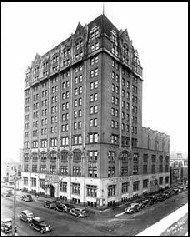
Minneapolis’ original YMCA Building, built at the corner of Ninth Street and LaSalle Avenue, was completed in 1919. The architects were Long, Lamoreaux, and Long (with Shattuck and Hussey, the leading architects in YMCA buildings in the West) who designed a number of historic buildings in Minneapolis. The twelve-story building was constructed in the Late Gothic Revival style. It was included in the National Register of Historic Places in 1995.
The YMCA of Minneapolis was started in 1866 to provide boarding places where moral and religious influences could impact the behavior of both boarders and members. The Minneapolis Star Tribune reported on June 25, 1966, that one hundred years previously, representatives of nine different churches met to “attend to the improvement of the spiritual, mental, and social condition of the community—particularly of the young men.”
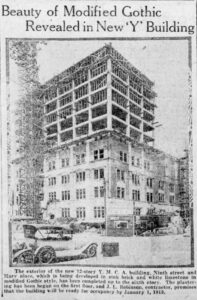
In 1880, the purpose expanded beyond the religious to support the intellectual, physical, and spiritual development of young boys and men. A survey in the early 1900s found that 28,000 young men were living away from home with an additional 5,000 added annually. A major fund-raising campaign resulted in the establishment of several YMCAs in the Minneapolis area which ultimately resulted in the 1916 campaign to raise money for a larger facility, at Ninth Street and LaSalle Avenue.
Construction started in 1917, and the building was completed in 1919. The building is composed of distinct layers, including a base, shaft, and top. Gothic was selected by the architects to emphasize the verticality and the symbolic association with churches. The raised basement is covered in gray granite blocks; the front façade to the third floor is finished with limestone. The upper floors are faced with red brick between limestone piers dividing the façade into seven bays. Window spandrels and Gothic tracery are in terra cotta. The eleventh and twelfth floors contain gables of terra cotta and tracery with stone coping. The building is topped with a moss-tiled mansard roof. The structure is predominantly reinforced concrete. When built, the red triangle representing the YMCA lit up the top of the building.
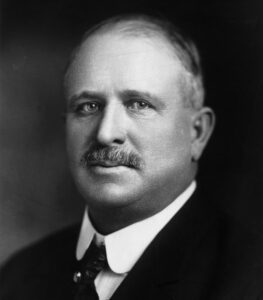
Construction of the building was motivated by a social need rather than the commercial need of other contemporary buildings. It was clear by 1914, that the YMCA had outgrown its current home and was meeting the needs of only a fraction of the boys and men in Minneapolis. In June of 1916, fundraising efforts raised $1,150,000 in ten days. The lot on which the YMCA was built was purchased at a cost of $150,000. The planned building would house not only facilities for men and boys but also the administrative offices of the YMCA.
Construction was delayed by the start of WWI in 1917. Materials had become tight. Because of the shortage of steel, reinforced concrete was selected as the primary construction material. By the time the building was completed in 1919, it could house returning soldiers. When completed, the building’s cafeteria could feed 1,000 people a day.
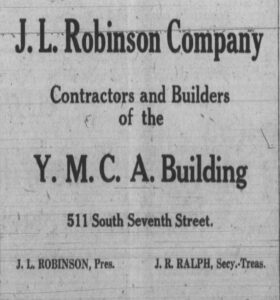
To address the financial need, the general contractor, J.L. Robinson, agreed to waive the general contractor fees and work on a cost and percentage basis. He agreed to work within the allotted budget. Robinson had done several other projects in Minneapolis including Dayton’s, the Shubert Theatre, and the Lincoln Bank Building. Robinson sold the company to Kraus Anderson (Matthew Kraus and Amos Anderson) in 1929 which continues to operate locally and nationally. Robinson retired in 1913.
The interior of the building, from the heavy, grilled door to the furnishings of the Association, followed the Gothic style. The vestibule was wainscoted in Tennessee marble and had an ornamental vaulted ceiling. There were 382 rooms with 250 sleeping rooms on the top eight floors with each room furnished with a bed/couch, desk, rocker, chair, and small table, all made of oak.
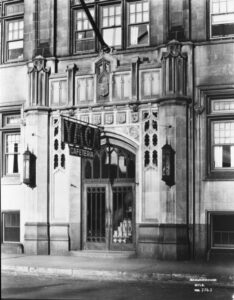
In addition to the dormitory rooms, there were social rooms, bowling alleys, a swimming pool, two gymnasiums, four handball courts, four exercise rooms, four locker rooms, and eleven rooms set aside for food service. There were also rooms for education, administration, and governance of the Association.
President William Howard Taft spoke in one of the community rooms in February of 1919.
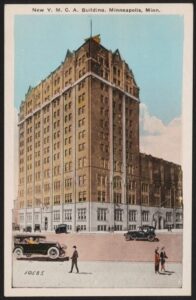
The building continued to operate as a YMCA. In 1956, the dormitory rooms were updated. The Minneapolis Star Tribune reported that the 285 resident rooms, other than receiving a coat of paint, had not been updated since 1919. In 1957, twelve balconies on the eleventh floor were removed and replaced by limestone and brick.
On January 6, 1980, the Minneapolis Star Tribune reported that the YMCA was seeking redevelopment of the block on which it was located. The YMCA building had deteriorated, and new space was needed. The Minneapolis Star Tribune reported on June 12, 1980, that the city was cool to the project, stating that the economics of the project did not work. There was already a surplus of office space.
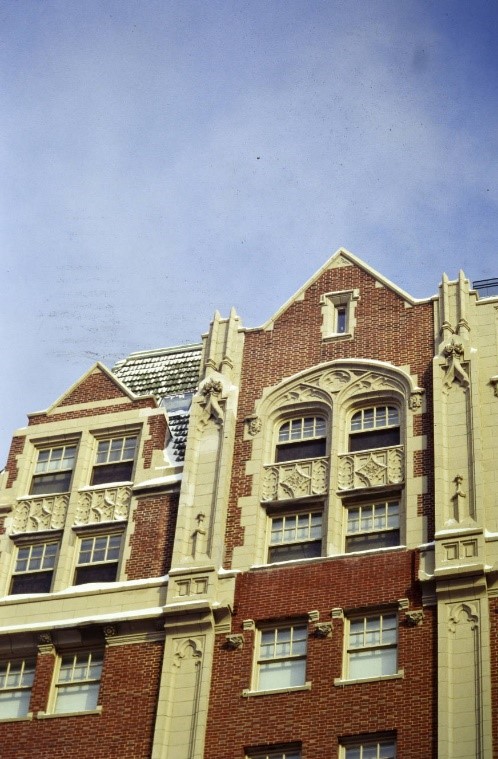
In 1981, the YMCA proposed a $90 million dollar project razing the entire city block except for the YMCA and State Theatre (both protected by their National Historic Registry). The project would include a new YMCA, retail and office space, and underground parking. The project was approved.
At the time, the dormitory rooms were still used as sleeping spaces. The Minneapolis Star Tribune of December 7, 1981, reported that the rooms could be rented for $57.50 to $92.50 per week including towel service and use of the facilities. Twenty-five percent of the rooms were leased to the Brotherhood of Railway and Airline Clerks to house those in training under a federal contract. During the 1970s, the YMCA was the fifth-largest hotel chain in the country.
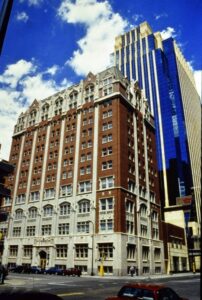
In 1990, the five-story four-bay portion on the north side (rear) of the building was removed. This section contained a pool, locker rooms, and ball courts. This area became part of the construction of LaSalle Plaza. The lobby entrance was also changed at that time.
In 1990, the YMCA moved to a new building on the west side of the original. The interior was then demolished with the removal of historic details and non-load-bearing walls. Only two Gothic fireplaces remained, and a few feet of oak paneling were preserved. In 1991-1992, the owner replaced doors and cleaned and tuck-pointed exterior walls.
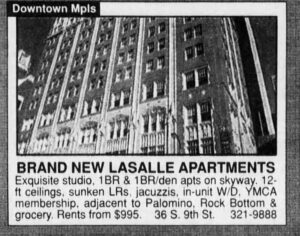
In 1994, the YMCA Building was converted into a 121-unit apartment complex. Leasing began in 1995.
The Minneapolis Star Tribune of December 3, 1994, noted that the first three floors of the building were converted into one-bedroom apartments with 12-foot ceilings, high windows, Jacuzzis, and angled walls. The building now has 122 apartments.
In 1995, the YMCA Building was placed on the National Register of Historic Places.
